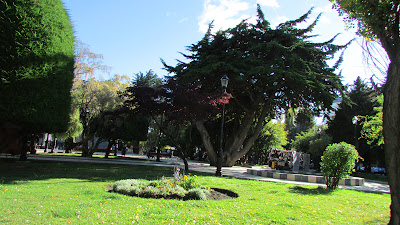In Punta Arenas the hotel we stayed at was Jose Nogueira, which was Bruce's (Bruce Sidell was my graduate advisor for both my Master's and Ph.D at the University of Maine), favorite hotel. Below is a picture of the hotel from the sidewalk. In Punta Arenas (or PA for short) there are A LOT of stray dogs, and you'll see one sleeping in the warm sun outside the hotel. However, they may not be completely "stray" dogs; many businesses put out food and water for these dogs, and unlike most of the stray dogs in the United States that are terrified of people, these dogs will walk along with people, not begging, but sort of in a pack. I however still find it a bit sad, especially when I see one that is injured. What is also exceptional about these dogs is that they know how to cross the street and they watch for traffic; just like people who are waiting for the light to change, so do the dogs. They don't randomly cross in front of cars, but maybe the ones that do either don't survive or else they learn that cars are not their friends. I did see one dog that walked on all four legs up to a street, waited for the light to turn and then limped across on three legs picking up is front left paw, and as soon as he had crossed the street he started walking normally again. I wish I got a video.
 |
| Hotel Jose Nogueira in Punta Arenas |
The glassed in area in the picture above is the dining room (below) where we had breakfast which consisted of coffee, fruit, meats and cheeses, a typical South American breakfast. There were grape vines inside the dining room, but since it is fall in the southern hemisphere, no grapes.
My room in the hotel was nice with two twin beds and overlooked the street, a typical street, not much different than a street in the United States. The room had two twin beds
 |
| My hotel room in Punta Arenas. |
 |
| Street view from hotel |
The toilet paper was interesting, and probably geared towards young children. There was a dog imprinted on the tissue and the word "Pare!", which means "Stop" or "Halt" in spanish. Cute, huh?
 |
| How to know how much toilet paper to use.... |
Next..... the Shackleton Bar.



















































